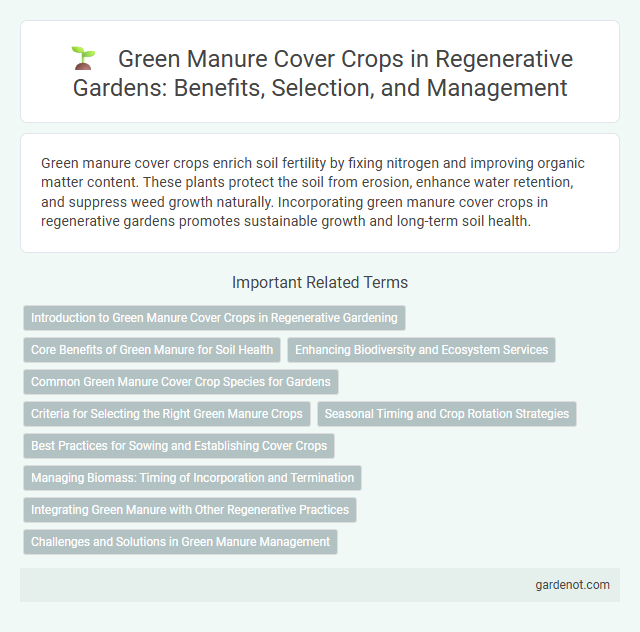Green manure cover crops enrich soil fertility by fixing nitrogen and improving organic matter content. These plants protect the soil from erosion, enhance water retention, and suppress weed growth naturally. Incorporating green manure cover crops in regenerative gardens promotes sustainable growth and long-term soil health.
Introduction to Green Manure Cover Crops in Regenerative Gardening
Green manure cover crops enhance soil fertility by fixing nitrogen and improving organic matter content in regenerative gardening. These plants, such as clover, vetch, and rye, protect soil from erosion, suppress weeds, and support microbial activity essential for nutrient cycling. Incorporating green manure cover crops increases soil structure resilience and promotes sustainable crop productivity without synthetic inputs.
Core Benefits of Green Manure for Soil Health
Green manure cover crops significantly enhance soil structure by increasing organic matter content and promoting microbial diversity. These plants fix atmospheric nitrogen, enriching soil fertility and reducing the need for synthetic fertilizers. Their deep root systems improve soil aeration and water retention, fostering healthier and more resilient garden ecosystems.
Enhancing Biodiversity and Ecosystem Services
Green manure cover crops significantly enhance biodiversity by providing habitat and food sources for beneficial insects, pollinators, and soil microorganisms. These plants improve ecosystem services such as nutrient cycling, soil structure, and moisture retention, fostering a resilient garden environment. Integrating diverse green manure species promotes natural pest control and supports a balanced, thriving regenerative garden ecosystem.
Common Green Manure Cover Crop Species for Gardens
Common green manure cover crop species for gardens include clover, vetch, rye, and buckwheat, which enrich soil fertility by fixing nitrogen and improving organic matter. Leguminous plants like clover and vetch are particularly effective in boosting soil nitrogen levels while rye provides excellent weed suppression and erosion control. Buckwheat grows quickly, suppresses weeds, and attracts beneficial insects, making it a valuable cover crop for maintaining garden health.
Criteria for Selecting the Right Green Manure Crops
Selecting the right green manure crops depends on factors such as soil type, climate, and crop rotation needs, ensuring optimal nitrogen fixation and organic matter addition. Crops like legumes (clover, vetch) are preferred for their nitrogen-fixing abilities, while grasses (rye, oats) excel at biomass production and erosion control. Matching the green manure crop's growth cycle with the garden's seasonal timeline maximizes soil health benefits and nutrient availability.
Seasonal Timing and Crop Rotation Strategies
Green manure cover crops are strategically planted during off-seasons to improve soil fertility and structure, capturing nutrients and preventing erosion. Seasonal timing aligns with crop rotation schedules to maximize nitrogen fixation and organic matter incorporation before the main crops are sown. Implementing diverse cover crops like legumes or grasses in rotation cycles enhances soil microbial activity and pest resilience while maintaining balanced nutrient availability.
Best Practices for Sowing and Establishing Cover Crops
Selecting fast-growing, nitrogen-fixing green manure cover crops such as clover, vetch, or buckwheat maximizes soil fertility and organic matter. Sow seeds in well-prepared, moist soil at appropriate depths, typically 1-2 inches, during early spring or after the main crop harvest to ensure vigorous establishment. Regularly monitor moisture levels and control weeds to support robust growth and root development, enhancing soil structure and nutrient cycling in regenerative gardens.
Managing Biomass: Timing of Incorporation and Termination
Effective management of biomass in regenerative gardens involves precise timing for the incorporation and termination of green manure cover crops. Incorporating biomass at the peak of nutrient accumulation maximizes soil fertility and organic matter content. Termination strategies aligned with crop cycles ensure optimal nutrient release and prevent competition for resources.
Integrating Green Manure with Other Regenerative Practices
Integrating green manure cover crops with other regenerative practices enhances soil health by increasing organic matter, improving nutrient cycling, and promoting microbial diversity. Combining green manure with crop rotation, no-till farming, and compost application maximizes nutrient retention and reduces erosion, boosting overall ecosystem resilience. This synergy supports sustainable plant growth while minimizing the need for synthetic fertilizers and chemical inputs.
Challenges and Solutions in Green Manure Management
Green manure cover crops often face challenges such as nutrient imbalances, pest infestations, and difficulties in timely incorporation into soil, which can hinder their effectiveness in regenerative gardening. Solutions include selecting appropriate leguminous species with high nitrogen-fixing capabilities, implementing integrated pest management strategies, and optimizing mowing or tilling schedules to enhance soil nutrient cycling and organic matter input. Proper green manure management improves soil health, increases microbial activity, and supports sustainable plant growth.
Green manure cover Infographic

 gardenot.com
gardenot.com